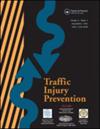Drug use among individuals injured in non-fatal motor vehicle crashes and related policies in 2023
IF 1.9
3区 工程技术
Q3 PUBLIC, ENVIRONMENTAL & OCCUPATIONAL HEALTH
引用次数: 0
Abstract
Objective
Although driving-related policies aimed at mitigating drug-related motor vehicle crashes (MVCs) have been implemented in diverse communities, data regarding their effectiveness are largely absent. A comprehensive evaluation of these policies is necessary. Furthermore, as US states legalize the recreational use of cannabis, the impact of these policies on drug-related crashes also needs to be evaluated. The objective was to assess the association between drug use prevalence among individuals (age 16+) injured in non-fatal MVCs in 2023 and various related policies, including drug-impaired driving policies, sobriety checkpoints, enforcement programs, and state cannabis legalization status.
Methods
We analyzed 2023 emergency medical services (EMS) records of individuals (age 16+) injured in non-fatal MVCs across 19 US states where EMS personnel indicated drug use, excluding duplicate, incomplete, and alcohol-only records. Using these counts, we calculated the prevalence of drug use among individuals (age 16+) injured in non-fatal MVCs in each state. The association between drug use prevalence and state-level policies, including drug-impaired driving laws (i.e., per se or zero tolerance), sobriety checkpoints, enforcement programs, and cannabis legalization laws, was evaluated using adjusted Poisson regression with random effects for state differences. Policies were assessed individually and in a full model to evaluate their individual and additive effects.
Results
In 2023, 11,538 individuals (68.2% male) were injured in drug-related non-fatal crashes. Neither drug-impaired driving policies, the use of sobriety checkpoints, nor the implementation of State Judicial Outreach Liaisons influenced the prevalence of drug use among individuals injured in non-fatal crashes. In contrast, relative to states with no policy or cannabidiol/low tetrahydrocannabinol, those permitting recreational cannabis had significantly higher prevalence (adjusted prevalence ratio [aPR]: 1.57, 95% confidence interval [CI]: 1.22, 2.02). The implementation of sobriety checkpoints was associated with higher drug use prevalence (aPR: 1.59, 95% CI: 1.22, 2.09) when drug-impaired driving policies were absent, particularly in states permitting recreational cannabis.
Conclusion
Our findings show differences in drug use prevalence among individuals (age 16+) injured in non-fatal MVCs based on state-level policies, highlighting the need for holistic enforcement strategies to address drug-related crashes, especially amid the increasing risks associated with the legalization of recreational cannabis use.
2023年非致命机动车碰撞伤者的药物使用情况及相关政策。
目的:尽管旨在减轻与毒品有关的机动车辆碰撞(MVCs)的驾驶相关政策已在不同社区实施,但关于其有效性的数据在很大程度上缺乏。对这些政策进行全面评价是必要的。此外,随着美国各州将娱乐性使用大麻合法化,这些政策对毒品相关事故的影响也需要进行评估。目的是评估2023年在非致命性车祸中受伤的个人(16岁以上)吸毒流行率与各种相关政策之间的关系,包括药后驾驶政策、清醒检查站、执法计划和州大麻合法化状况。方法:我们分析了美国19个州急诊医疗服务(EMS)人员指出使用药物的非致命性MVCs中受伤个人(16岁以上)的2023份急救医疗服务(EMS)记录,不包括重复、不完整和仅酒精记录。使用这些计数,我们计算了每个州在非致命性mvc中受伤的个人(16岁以上)中药物使用的流行程度。使用调整后的泊松回归(Poisson regression)对各州差异的随机效应进行了评估,评估了毒品使用流行程度与州一级政策之间的关系,包括药物损害驾驶法(即本身或零容忍)、清醒检查站、执法计划和大麻合法化法律。政策被单独评估,并在一个完整的模型中评估它们的个体和附加效应。结果:2023年,11538人(68.2%为男性)在与毒品有关的非致命车祸中受伤。药物影响下的驾驶政策、使用清醒检查点以及实施国家司法外联联络站都没有影响在非致命车祸中受伤的个人中使用药物的流行程度。相比之下,与没有大麻二酚/低四氢大麻酚政策的州相比,允许休闲大麻的州的患病率明显更高(调整患病率比[aPR]: 1.57, 95%置信区间[CI]: 1.22, 2.02)。在没有药物损害驾驶政策的情况下,特别是在允许娱乐性大麻的州,实施清醒检查点与较高的药物使用发生率相关(aPR: 1.59, 95% CI: 1.22, 2.09)。结论:我们的研究结果显示,在州一级政策的基础上,在非致命性车祸中受伤的个人(16岁以上)中,药物使用的流行程度存在差异,强调需要采取全面的执法策略来解决与毒品有关的撞车事故,特别是在娱乐性大麻使用合法化相关的风险不断增加的情况下。
本文章由计算机程序翻译,如有差异,请以英文原文为准。
求助全文
约1分钟内获得全文
求助全文
来源期刊

Traffic Injury Prevention
PUBLIC, ENVIRONMENTAL & OCCUPATIONAL HEALTH-
CiteScore
3.60
自引率
10.00%
发文量
137
审稿时长
3 months
期刊介绍:
The purpose of Traffic Injury Prevention is to bridge the disciplines of medicine, engineering, public health and traffic safety in order to foster the science of traffic injury prevention. The archival journal focuses on research, interventions and evaluations within the areas of traffic safety, crash causation, injury prevention and treatment.
General topics within the journal''s scope are driver behavior, road infrastructure, emerging crash avoidance technologies, crash and injury epidemiology, alcohol and drugs, impact injury biomechanics, vehicle crashworthiness, occupant restraints, pedestrian safety, evaluation of interventions, economic consequences and emergency and clinical care with specific application to traffic injury prevention. The journal includes full length papers, review articles, case studies, brief technical notes and commentaries.
 求助内容:
求助内容: 应助结果提醒方式:
应助结果提醒方式:


